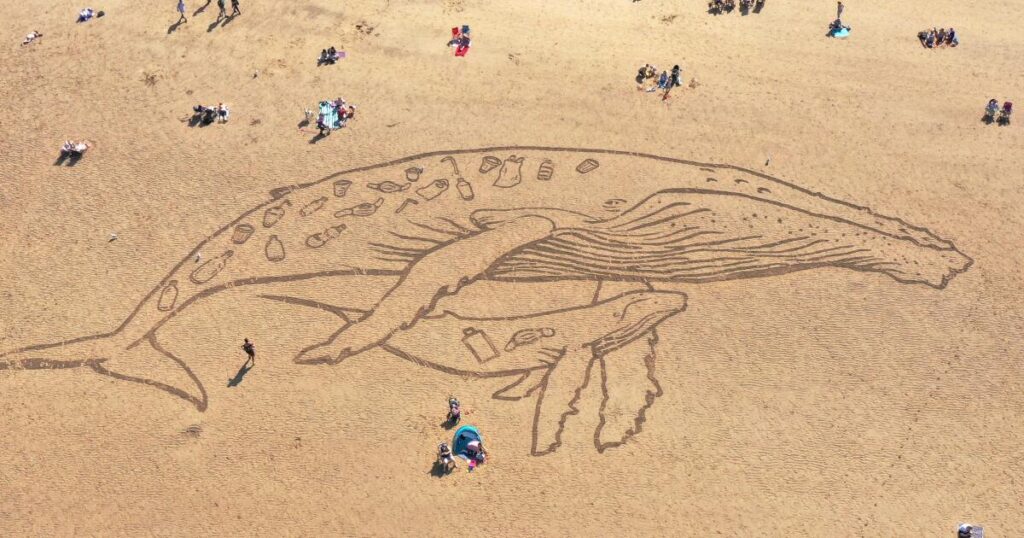Ocean plastic kills sea creatures. It can obstruct, perforate or twist their airways and gastrointestinal tracts.
Now new research shows it takes just 6 pieces of ingested rubber the size of a pencil eraser to kill most sea birds.
For marine mammals, 29 pieces of any kind of plastic — hard, soft, rubber or fishing equipment — is often lethal.
It’s the first time researchers have quantified how much and what kind of plastic — soft, hard, rubber or fishing debris — is needed to kill a bird, marine mammal or a turtle.
“I think the lethal doses that we saw were smaller than I expected,” said Erin Murphy, a researcher with the Ocean Conservancy and the department of ecology and evolution at the University of Toronto.
“Seeing the particularly small thresholds for rubber and seabirds, for example, that just six pieces of rubber, each smaller on average than the size of a pea was enough to kill 90% of sea birds that ingested it … That was particularly surprising to me,” she said.
The sea birds were less sensitive to hard plastic: It’d take 25 pieces of the pea-sized hard plastic pieces to ensure a 90% chance of dying.
Murphy and her colleagues from the University of Tasmania, in Australia, the Commonwealth Scientific and Industrial Research Organisation, also from Australia, and the Universidade Federal de Alagoas, in Brazil, published their study Monday in the journal Proceedings of the National Academies of Science.
For decades, researchers have been documenting death by plastic in marine animals. They have reported it in the gastrointestinal tracts of nearly 1,300 marine species — including every species of sea turtle, and in every family of seabird and marine mammal family.
The team analyzed data from 10,412 published necropsies, or animal autopsy reports. Of the animals studied, 1,306 were sea turtles representing all seven species of sea turtles; 1,537 were seabirds representing 57 species; and 7,569 were marine mammals across 31 species.
They found that 35% of the dead seabirds, 12% of marine mammals and 47% of sea turtles examined had ingested plastic. Seabirds seemed to be particularly sensitive to rubber. For marine mammals, soft plastics — such as plastic bags — and fishing debris was most harmful. For sea turtles, their kryptonite was hard and soft plastics.
“This was severe trauma or damage to the GI tract, or blockage of the stomach or intestines from plastic… and so these were physical harms that you could see, that you could see in the gut of these animals, and that were reported by scientists,” said Murphy describing the reports.
The paper did not look at other ways plastic can kill marine animals — strangulation, entanglement and drowning.
Nor did it look at malnutrition or toxicity caused by eating plastic.
“So, this is likely an underestimate of the impacts of ingestion, and it’s definitely an underestimate of the lethality of plastics more broadly,” said Murphy.
Nearly half the animals in their analysis were threatened or endangered species.
More than 11 million metric tonnes — or more than 24 billion pounds — of plastic enters the world’s oceans every year, according to several environmental and industry reports. That’s a garbage truck’s worth dumped every minute.
According to the United Nations, that number is expected to triple in the next twenty years.
“I find this piece a brilliant contribution to the field,” said Greg Merrill, a researcher with the Duke University Marine Lab, who did not participate in the study.
“We have thousands of examples of marine animals ingesting plastic debris. But for a number of reasons, eg. lack of data, difficulty of conducting laboratory-based experiments, and ethical considerations, risk assessments are really challenging to conduct,” he said in an email.
Such assessments are crucial for actually linking plastic ingestion to mortality, because “once we know some of those thresholds, they can help policy makers make informed decisions,” said Merrill.
And that’s what Murphy said she and her co-authors are hoping for: That lawmakers and others can use this information to reduce plastic, by crafting regulations to ban or reduce plastics, such as plastic bag or balloon bans, and encouraging small, local events such as beach clean ups.
“The science is clear: We need to reduce the amount of plastic that we’re producing and we need to improve collection and recycling to clean up what’s already out there,” said Murphy.
Earlier this year, in internationals talks on limiting plastic pollution, oil and gas producing countries succeeded in preventing language that would reduce the amount of plastics produced.
The post How little plastic does it take to kill marine animals? Scientists have answers appeared first on Los Angeles Times.




